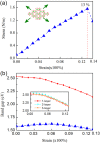Single Layer Bismuth Iodide: Computational Exploration of Structural, Electrical, Mechanical and Optical Properties
- PMID: 26626797
- PMCID: PMC4667189
- DOI: 10.1038/srep17558
Single Layer Bismuth Iodide: Computational Exploration of Structural, Electrical, Mechanical and Optical Properties
Abstract
Layered graphitic materials exhibit new intriguing electronic structure and the search for new types of two-dimensional (2D) monolayer is of importance for the fabrication of next generation miniature electronic and optoelectronic devices. By means of density functional theory (DFT) computations, we investigated in detail the structural, electronic, mechanical and optical properties of the single-layer bismuth iodide (BiI3) nanosheet. Monolayer BiI3 is dynamically stable as confirmed by the computed phonon spectrum. The cleavage energy (Ecl) and interlayer coupling strength of bulk BiI3 are comparable to the experimental values of graphite, which indicates that the exfoliation of BiI3 is highly feasible. The obtained stress-strain curve shows that the BiI3 nanosheet is a brittle material with a breaking strain of 13%. The BiI3 monolayer has an indirect band gap of 1.57 eV with spin orbit coupling (SOC), indicating its potential application for solar cells. Furthermore, the band gap of BiI3 monolayer can be modulated by biaxial strain. Most interestingly, interfacing electrically active graphene with monolayer BiI3 nanosheet leads to enhanced light absorption compared to that in pure monolayer BiI3 nanosheet, highlighting its great potential applications in photonics and photovoltaic solar cells.
Figures





References
-
- Cao G. Atomistic Studies of Mechanical Properties of Graphene. Polymers 6, 2404–2432, 10.3390/polym6092404 (2014). - DOI
-
- Nicolosi V., Chhowalla M., Kanatzidis M. G., Strano M. S. & Coleman J. N. Liquid Exfoliation of Layered Materials. Science 340, 10.1126/science.1226419 (2013). - DOI
-
- Tang Q. & Zhou Z. Graphene-analogous low-dimensional materials. Prog. Mater Sci. 58, 1244–1315, 10.1016/j.pmatsci.2013.04.003 (2013). - DOI
Publication types
LinkOut - more resources
Full Text Sources
Other Literature Sources
Miscellaneous

